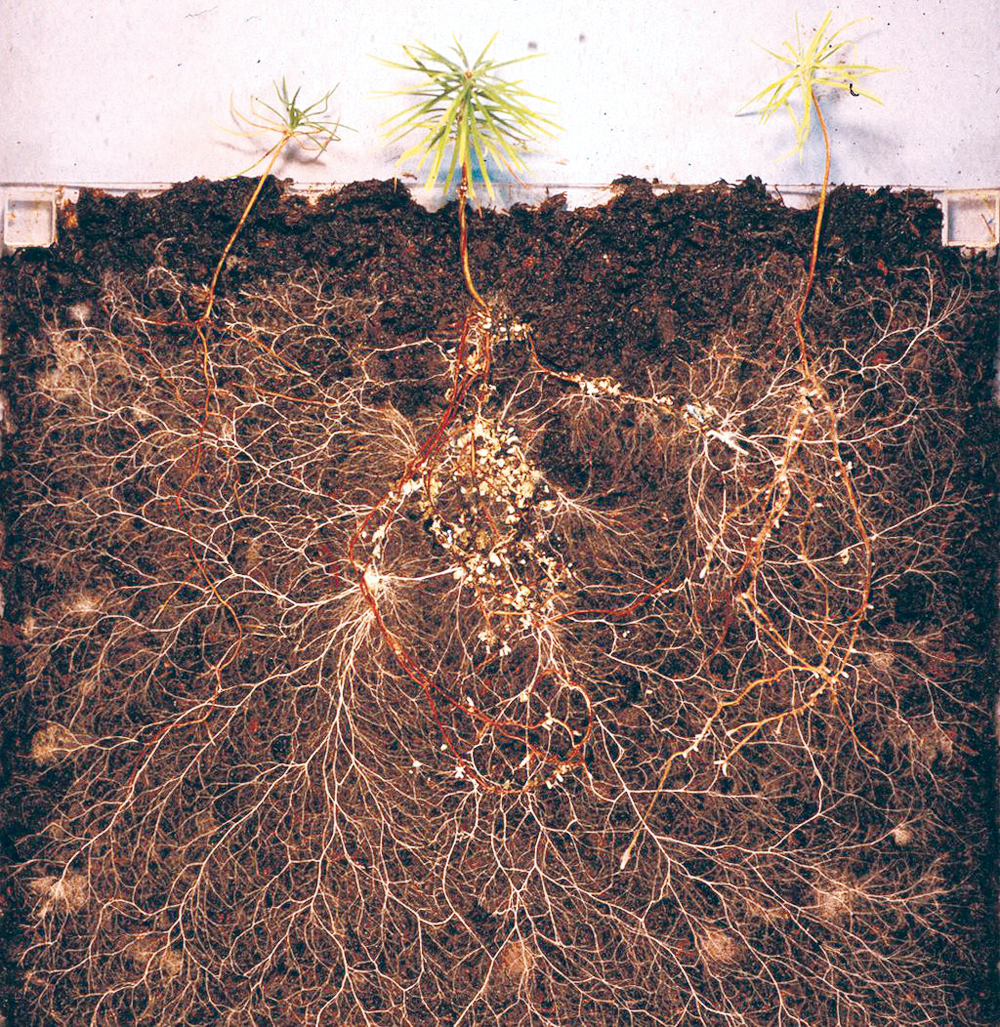 by Linda Harvey by Linda Harvey
Typically the word “fungus” tends to evoke images of decay, disease, rot and degradation. It is interesting, then, to know that there are large numbers of fungi, whole groups of them, which dedicate their lives to supporting and nurturing living plants.
These are the mycorrhizal fungi, so named because they associate with the roots of plants (myco = fungus, rhiza = root). This relationship is symbiotic, or mutually beneficial. These fungi deliver trace minerals and other nutrients to the plant roots and in return accept sugars, proteins and other materials manufactured by the plant. This synergistic relationship has been so successful that is has persisted in the biological kingdom for 450 million years.
The first plant-like organisms that found themselves in the shallows of the seashore, and washed up on land to evolve into the plants we know today, were associated with fungi which helped them survive. Most, but not all, of the plants in existence today are entwined with mycorrhizal fungi.
Just as plants come in a vast array of shapes and sizes, there are different types of fungi. Endomycorrhizal fungi (endo = inside), such as the very common arbuscular mycorrhizae now found for sale in many garden centres, actually penetrate the cells of roots. Once inside, they make a finely branched knot or arbuscule for the purpose of nutrient exchange. With over 300 species of endomycorrhizae, they colonize some 80% of the world’s plants.
Ectomycorrhizal fungi (ecto = outside) colonize many of the remaining members of the plant kingdom. These fungi do not penetrate the root cells, but form a fine net around them, where nutrient exchange occurs. They can form vast, intertwined networks among forest trees. A few plants, such as those that move into disturbed areas, do not have mycorrhizal partners.
In addition to providing and sharing nutrients, often from much farther away than the plant’s own roots could ever reach, these fungal networks can also act to selectively nurture young plants in need, or other struggling individuals valuable to the whole.
The vast, intertwined networks mentioned above can also have a communication function. Chemical signals can travel through the fungal hyphae and into the roots of plants to inform individuals about happenings in other parts of the network. For instance, if a plant is suddenly under insect attack, signals of warning may be sent out, which can allow nearby plants to gear up their protection, such as increasing bitter or toxic compounds in their leaves. Sometimes the natural predators of the attackers may be chemically alerted that lunch is being served.
This world of incredible complexity is right under our noses, and our feet. Who knew?
So what is our responsibility toward this complex and delicate world? If a forest is a sentient being, what are the ethical implications? How can we respect and protect our little friends in the way we farm? For they are serving us, and could serve us better if we quit destroying them and interfering with their work.
This worthy task will require nothing less than a complete review and rethink of all our farming practices, ancient and modern. Herbicides, fungicides and other pesticides are clearly detrimental to this fungal network. Tillage is problematical. Cover crops are good—mycorrhizal fungi need plant roots to survive.
Seeds sown indoors should be introduced at germination to the fungal partners that will accompany them through life. Field crops can benefit from these additions as well. Woodlot management strategies need to protect the soil and its fungal networks.
Rather than isolating and depriving our crops, let’s offer them the support and nurturing that nature intended through the mycorrizal fungi.
Recommended Reading:
Phillips, Michael, Mycorrhizal Planet: How Symbiotic Fungi Work with Roots to Support Plant Health and Build. Chelsea Green Publishing, White River Junction, Vermont, USA. 2017
Sheldrake, Merlin, Entangled Life: How Fungi Make Our Worlds, Change Our Minds & Shape Our Futures. Random House, London, UK. 2020
Wohlleben, Peter, The Hidden Life of Trees. Greystone Books Ltd., Vancouver, British Columbia, Canada. 2015
|


![]()

 by Linda Harvey
by Linda Harvey